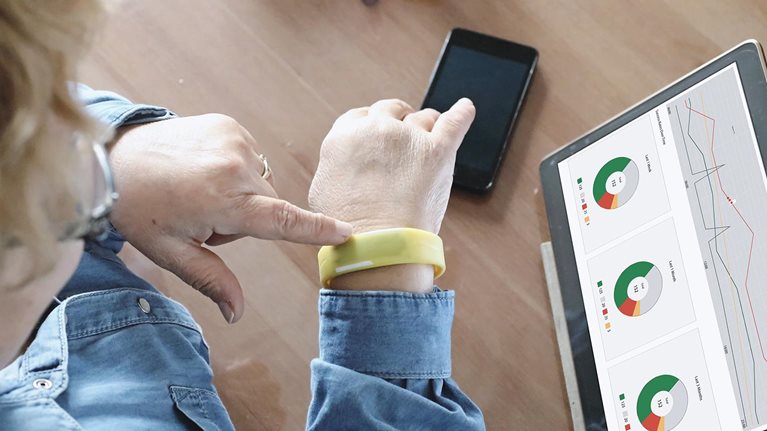The recently published eHealth Monitor 2021 is McKinsey’s second annual review of the progress of digitization in German healthcare. The first part of the report describes where Germany stands in digitization of its healthcare, and the second focuses on digital health applications (DiGA) using the new German reimbursement pathway.
The report captures the broad spectrum of the German healthcare system’s stakeholders: hospitals, outpatient physicians, telemedicine providers, pharmacies, health insurers, patients, and insured citizens. It is based on information drawn from professional associations such as the KBV PraxisBarometer; scientific publications; commercial analyses such as the HIMSS Trend Barometer, EPatient Analytics, Priori Data, and AppTweak; and McKinsey’s own research. The report contains data collected primarily through the end of August 2021, although some indicators relate to 2019 or 2020.
Part one: Where Germany stands in healthcare digitization
Pulling together 30 indicators, part one of the eHealth Monitor 2021 illustrates where German healthcare currently stands in areas such as its regulatory framework, digital infrastructure, supply and demand for e-health solutions, and the usage and benefits of e-health solutions.
Regulatory framework for e-health
New legislation supports healthcare digitization. A total of seven bills focused on e-health were introduced between 2019 and 2021. They were intended to improve the regulatory framework for the digitization of Germany’s healthcare system and to accelerate the expansion of its digital infrastructure by encouraging the introduction of electronic health records and e-prescriptions. With these bills, Germany has strengthened its e-health foundation and is closing the gap with Europe’s e-health pioneers, Scandinavia and the United Kingdom.
Digital infrastructure and digital maturity
The adoption of digital infrastructure by physicians has increased significantly. According to a recent study, more than 90 percent of general practitioners in Germany are now connected to the telematics infrastructure, the backbone of the German digital healthcare system.1 Above-average connection rates occur among younger physicians in private practices, psychotherapists aged 50 or under, and medium-size to large family medicine practices.
However, digitization has not yet resulted in digital data exchange between hospitals and outpatient physicians: Ninety-five percent of communication between outpatient physicians and hospitals is still paper based. The Hospital Future Act (KHZG) has infused €4.3 billion into hospital IT to remedy this situation by accelerating the digitization of German hospitals.
Digital supply and demand
Ambulatory physicians are adopting digital solutions cautiously. Digital service availability is growing among outpatient physicians by 18 percent a year. However, nearly half of them (46 percent) are concerned that digitization could harm the doctor–patient relationship.
Telemedicine consultations have increased significantly, from fewer than 3,000 doctor–patient interactions in 2019 to 2.7 million in 2020, a 900-fold increase. Telemedicine consultations peaked during the COVID-19 lockdown, with 1.2 million in the second quarter of 2020 (Exhibit 1).

Digital offerings from health insurers have increased. Health insurers are offering their insured population ever more digital services, but so far, the uptake has been limited. For example, every statutory health insurer was required to provide its customers with an electronic health record by January 1, 2021. Six months later, fewer than 0.4 percent of the insured population of the top 20 insurers had downloaded their file.
Acceptance and use of e-health solutions by patients
Low patient awareness of digital health offerings. In a May 2020 survey by Doctolib, 55 percent of respondents indicated they were open to the idea of digital health offerings, but many complained of a lack of information or education about them. A study in late 2020 found that 40 percent of respondents were unaware of the forthcoming launch of downloadable electronic health records in January.2
Increasing uptake of e-health apps. E-health apps are gaining in popularity. Between the fall of 2019 and the summer of 2021, the number of downloads of the top 40 e-health apps doubled to 2.4 million. The most popular category was online appointment booking. In the second quarter of 2021, the top five e-health apps were downloaded more than 400,000 times, a tenfold increase over the second quarter of 2019 (Exhibit 2).

DiGA, a new regulatory and reimbursement pathway for digital health applications
From June 2020 to November 2021, 104 DiGAs have been submitted for inclusion in the list issued by the Federal Institute for Drugs and Medical Devices (BfArM), Germany’s medical regulatory authority under the Federal Ministry of Health. As of November 2021, 24 DiGAs have been approved; 57 failed to meet the criteria for certification or were withdrawn, and the remaining 23 were still under review.
The scaling of DiGA is still in its early stages. The nine DiGAs available had fewer than 200,000 combined downloads by July 31, 2021. To put this number into perspective, 685 million prescriptions were written in Germany in 2020, according to the AOK Research Institute.
Increasing evidence of the benefits of e-health
The number of German research publications about e-health solutions has increased almost sixfold in the past decade, from 20 in 2010 to 116 in 2020. This is still only half as many publications as in the United Kingdom, which has the highest number of e-health publications in Europe. Of the academic publications that assess the potential benefits of e-health, 84 percent indicate the applications have benefits, with three-quarters showing an improvement in patient outcomes. In addition, 10 percent show an improvement in cost efficiency, and 14 percent show that healthcare professionals benefit from time savings.
Part two: Digital health applications using the new DiGA regulatory/reimbursement pathway
Part two of the report addresses the following focus topic: digital health applications using the new German DiGA regulatory/reimbursement pathway. It provides our assessment of the current situation after one year of DiGA, along the following dimensions:
- DiGA as another pillar of regular care. DiGAs constitute the fourth pillar of regular care in Germany, alongside prescription drugs, medical devices, and other therapies such as physiotherapy and speech therapy. High security requirements, proven evidence, and the possibility of continuous development are characteristics of the DiGA regulatory pathway.
- Development, typology, and use of listed applications. Nearly 50 percent of DiGAs support treatment for mental and behavioral disorders. Medical education of patients and symptom tracking are among its most common features.
- DiGA manufacturers and their cooperation partners. To date, DiGA manufacturers generally rely on other healthcare stakeholders to develop or codevelop and market their applications. Preferred partners include university hospitals, private and statutory health insurers, and pharmaceutical companies.
- DiGA pricing. A DiGA costs the healthcare system between €204 and €744 for 90 days of use, and prices for the first year are set by manufacturers. This is followed by negotiations between manufacturers and insurers to determine the price going forward.
- The importance of DiGAs to future healthcare. Physicians, health insurers, and patients will have a continued influence on the acceptance of DiGAs as an integral part of patient care. The creation of self-contained digital ecosystems for specific conditions or treatments will likely accelerate DiGA uptake.
In addition to McKinsey’s DiGA assessment in the eHealth Monitor 2021 report, there are several external perspectives on the opportunities and challenges of DiGAs, including those of two start-ups, Selfapy and Mika/Fosanis, and one of the largest insurers, AOK Bayern. The view of physicians as catalysts for DiGA adoption is covered in a guest article based on a survey of 2,000 physicians. The regulatory authority, BfArM, takes stock of the first DiGA year. And an article about European apps by Petra Hoogendoorn, an international expert in health app assessment, rounds off the review.
The eHealth Monitor 2021 report closes with a perspective from Gottfried Ludewig of the Federal Ministry of Health on the future of e-health in Germany. He notes how the COVID-19 pandemic has catalyzed recognition of the benefits of digitization and is confident that the national e-health infrastructure will grow, partly because of the significant legislative activity of recent years. And he notes that the protected and standardized use of data for research will further expand at the national level and also for Europe.


